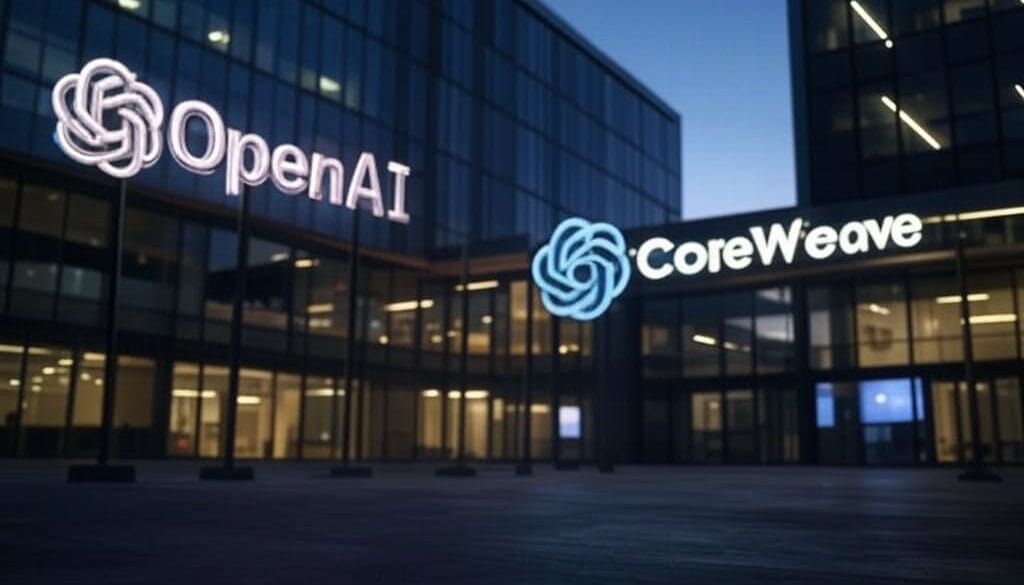OpenAI’s $12 Billion Bet on CoreWeave: A Game-Changer for AI Infrastructure
Introduction
Every day, technology pushes the boundaries of what’s possible, turning yesterday’s science fiction into today’s reality. Isn’t it amazing that we live in an era where innovation is not just an option but a necessity? From AI-driven automation to quantum computing, technologies are advancing faster than ever before. The 21st century is all about AI and technology, and every day, there is something new coming on.
Recently, news came that OpenAI has done a massive 5-year $11.9 to $12 billion deal with Coreweave, an NVIDIA bank cloud computing startup. It would not be wrong to think that this partnership is not just a financial flex but a strategic plan that could redefine how AI giants scale their computational muscle.
In this guide will be sharing some insights on the deal what is the deal about and much more so let’s dive deep!
DON’T HAVE TIME TO READ? LISTEN IT…
OR WATCH THE VIDEO….
Table of Contents

What is CoreWeave?
CoreWeave is a cloud computing company specializing in providing infrastructure for artificial intelligence (AI) and other compute-intensive workloads. Here are some key points about CoreWeave:
- Specialization: The company CoreWeave focuses on delivering high-performance computing services there is specifically designed for AI model training and deployment. Moreover, it uses a network of data centers that has been equipped with thousands and thousands of NVIDIA GPUs which are highly advanced and are essential for AI processing and computing.
- Backed by Nvidia: CoreWeave is supported by Nvidia, which holds a stake in the company. This partnership allows CoreWeave to offer cutting-edge GPU technology to its clients.
- Major Clients: CoreWeave largest client until now has been Microsoft which accounted for a significant proportion of its revenue however the recent deal with open AI marks the significant expansion of its client base.
- IPO Plans: CoreWeave is preparing for an initial public offering (IPO), which is expected to be one of the largest in recent years. The company aims to raise substantial funds to further grow its operations
- Technology and Services: CoreWeave offers a cloud platform designed specifically for AI and other compute-intensive tasks. It provides services like VFX rendering, bare metal computing, and AI compute acceleration
CoreWeave is often referred to as the “AI Hyperscaler” due to its focus on scaling AI infrastructure for leading AI labs and enterprises
Computing Services
- Definition: Computing services refer to the availability of resources to perform computational work via a third party. This includes access to processing power, memory, storage, and networking capabilities
- Examples: Computing services can be delivered through various models, such as Infrastructure-as-a-Service (IaaS), Platform-as-a-Service (PaaS), and Software-as-a-Service (SaaS). These models allow users to access computing resources without managing the underlying infrastructure themselves6.
Cloud Computing
- Definition: Cloud computing is the on-demand delivery of computing resources—such as servers, storage, databases, networking, software, analytics, and intelligence—over the internet. Users pay only for the resources they use, which helps reduce costs and increase scalability
- Key Features:
- On-Demand Access: Users can access computing resources as needed without having to purchase or maintain physical infrastructure
- Pay-Per-Use Pricing: Costs are based on actual usage, reducing upfront expenses
- Scalability: Resources can be easily scaled up or down to match changing business needs
- Service Models: IaaS, PaaS, and SaaS are common service models in cloud computing
Comparison of Computing Services and Cloud Computing
| Feature | Computing Services | Cloud Computing |
| Access | Access to computational resources via a third party. | On-demand access to computing resources over the internet. |
| Pricing | Typically pay for services used. | Pay-per-use pricing model. |
| Scalability | Can be scalable depending on the provider. | Highly scalable to meet changing demands. |
| Infrastructure Management | Often managed by the service provider. | Users do not manage the underlying infrastructure. |
In summary, computing services provide access to computational resources, while cloud computing is a specific model that delivers these resources over the internet with a focus on scalability and cost efficiency.

What is the deal of OpenAI and Coreweave?
- Partnership: OpenAI, the company behind ChatGPT, has signed a five-year contract with CoreWeave, a cloud computing company specializing in AI services.
- Value: The deal is worth approximately $11.9 billion.
- Purpose: CoreWeave will provide OpenAI with dedicated computing resources to support the development and deployment of its AI models.
Key Points:
- Investment: As part of the deal, OpenAI will receive a $350 million stake in CoreWeave through a private placement during CoreWeave’s upcoming initial public offering (IPO).
- CoreWeave’s Role: CoreWeave is backed by Nvidia and operates a network of data centers equipped with thousands of Nvidia GPUs, which are crucial for AI computing.
- Impact: This partnership is significant for both companies, as it enhances OpenAI’s computing capabilities and provides a major boost to CoreWeave ahead of its IPO.
Why the deal of OpenAI and Coreweave Important?
- The deal highlights the growing demand for high-performance computing infrastructure in the AI sector.
- It also underscores OpenAI’s efforts to diversify its partnerships beyond its primary investor, Microsoft, by investing in CoreWeave.
How it will help OpenAI?
The partnership between OpenAI and CoreWeave, valued at $11.9 billion over five years, is expected to significantly benefit OpenAI in several ways:
- Access to High-Performance Computing Resources:
- GPU Capacity: CoreWeave provides access to a vast network of Nvidia GPUs, which are essential for training and deploying advanced AI models. This will help OpenAI meet its growing demand for computing power to support its AI development.
- Scalability: The deal ensures OpenAI can scale its AI operations efficiently, supporting the development of more complex models like those used in ChatGPT.
- Strategic Equity Stake:
- Ownership in CoreWeave: OpenAI will acquire a $350 million equity stake in CoreWeave, making it a shareholder. This strategic move secures long-term access to critical GPU resources and deepens the partnership between the two companies.
- Influence and Independence: By investing in CoreWeave, OpenAI gains more control over its computing infrastructure, potentially reducing dependence on other providers like Microsoft.
- Enhanced Infrastructure Portfolio:
- Diversification: The partnership complements OpenAI’s existing relationships with companies like Microsoft and Oracle, enhancing its infrastructure capabilities and diversifying its partnerships.
- Competitive Advantage: This deal positions OpenAI to better compete in the AI landscape by securing crucial computing resources, which are in high demand.
- Long-Term Growth and Innovation:
- Future Development: The collaboration is expected to drive innovation in AI technology, supporting OpenAI’s mission to advance AI capabilities and applications.
- Market Positioning: By securing a major stake in CoreWeave, OpenAI strengthens its market position and prepares for future growth in the AI sector
What new AI technologies might emerge from this partnership?
- Generative AI Models:
- Advancements in GANs and Large Language Models: With access to more powerful computing resources, OpenAI could further develop and refine generative models like GANs and large language models (e.g., GPT-4 and beyond). These models could generate more realistic images, videos, or text, pushing the boundaries of creative content generation
- Explainable AI (XAI):
- Transparency in AI Decision-Making: The partnership might focus on developing more transparent AI systems through XAI, enabling better understanding and trust in AI decision-making processes. This could be crucial for applications where accountability is essential
- Reinforcement Learning (RL):
- Autonomous Systems: Enhanced computing capabilities could accelerate the development of RL-based autonomous systems, such as self-driving cars or robots, by allowing for more complex simulations and training scenarios
- Predictive AI Analytics:
- Advanced Forecasting and Optimization: With CoreWeave’s infrastructure, OpenAI could enhance predictive analytics capabilities, enabling more accurate forecasting and optimization in various industries, such as finance or healthcare
- Hybrid AI Systems:
- Combining Rule-Based and Machine Learning Approaches: The partnership might explore hybrid AI systems that integrate traditional rule-based systems with machine learning, offering a balance between interpretability and predictive power
- Federated Learning:
- Privacy-Preserving AI Development: By leveraging CoreWeave’s computing resources, OpenAI could develop more sophisticated federated learning models, which allow AI training on diverse data sets without compromising privacy
- Natural Language Processing (NLP):
- Advanced Language Models: The collaboration could lead to further advancements in NLP, enabling more sophisticated language understanding and generation capabilities, which are crucial for applications like chatbots and virtual assistants
These technologies could significantly enhance OpenAI’s capabilities in AI research and development, leading to innovative applications across various sectors.
How could this partnership influence the future of AI in education?
The partnership between OpenAI and CoreWeave could significantly influence the future of AI in education by enhancing the capabilities of AI systems used in educational settings. Here are some potential impacts:
- Personalized Learning:
- Advanced AI Models: With access to CoreWeave’s high-performance computing resources, OpenAI could develop more sophisticated AI models capable of providing personalized learning experiences. These models can analyze vast amounts of data to tailor educational content to individual students’ needs, pace, and learning style.
- Enhanced Adaptive Learning: The partnership could lead to more advanced adaptive learning systems that adjust difficulty levels and content in real-time based on student performance, similar to platforms like Squirrel Ai
- Teacher Support and Efficiency:
- Automation of Administrative Tasks: AI tools can automate tasks such as grading, attendance tracking, and other administrative duties, freeing teachers to focus on mentoring and providing meaningful feedback
- Content Creation: Teachers can use AI tools like OpenAI’s ChatGPT to create customized lesson plans and materials more efficiently, reducing preparation time and enhancing classroom engagement
- Accessibility and Inclusivity:
- AI-Driven Assistive Technologies: The partnership could accelerate the development of AI-driven assistive technologies that make education more accessible for students with disabilities, such as real-time translations and speech-to-text tools
- Global Reach: By leveraging AI, educational institutions can extend high-quality learning resources to underserved regions, bridging geographic and economic gaps in education
- Innovation and Collaboration:
- Industry-School Partnerships: The collaboration between OpenAI and CoreWeave could inspire more partnerships between tech companies and educational institutions, fostering innovation and ensuring that AI technologies meet the specific needs of the education sector
- Teacher Training and Development: As AI becomes more integral to education, there will be a greater need for teacher training programs that focus on integrating AI tools effectively into teaching practices
Overall, this partnership has the potential to transform education by leveraging AI to enhance learning outcomes, support teachers, and make education more accessible and inclusive.

How might this partnership revolutionize industries like healthcare or finance?
The partnership between OpenAI and CoreWeave has the potential to revolutionize industries like healthcare and finance by leveraging advanced AI technologies. Here are some ways this partnership could impact these sectors:
Healthcare
- Personalized Medicine:
- AI-Driven Diagnostics: With access to high-performance computing resources, AI models can analyze vast amounts of medical data to provide more accurate diagnoses and personalized treatment plans.
- Predictive Analytics: AI can help predict patient outcomes, allowing healthcare providers to intervene early and improve patient care.
- Medical Research:
- Accelerated Discovery: AI can accelerate the discovery of new treatments by analyzing large datasets to identify patterns and potential therapeutic targets.
- Clinical Trials Optimization: AI can optimize clinical trial design and patient selection, making the process more efficient and effective.
- Healthcare Accessibility:
- Telemedicine and AI Assistants: AI-powered chatbots and virtual assistants can enhance telemedicine services, providing patients with easier access to healthcare advice and support.
Finance
- Risk Management and Compliance:
- AI-Driven Risk Analysis: Advanced AI models can analyze financial data to predict and mitigate risks, ensuring compliance with regulatory requirements.
- Fraud Detection: AI can identify patterns indicative of fraudulent activities, helping financial institutions protect their assets.
- Investment Strategies:
- AI-Driven Portfolio Management: AI can analyze market trends and make predictions to optimize investment portfolios, potentially leading to better returns.
- Automated Trading Systems: AI can automate trading decisions based on real-time market data, reducing human error and increasing efficiency.
- Customer Service and Experience:
- AI-Powered Customer Support: AI chatbots can provide personalized customer support, enhancing user experience and reducing operational costs.
- Personalized Financial Products: AI can help tailor financial products and services to individual customer needs, improving customer satisfaction and loyalty.
Overall, this partnership could lead to significant advancements in healthcare and finance by leveraging AI to improve efficiency, accuracy, and accessibility across these industries.
What innovative applications of AI could arise from this partnership?
The partnership between OpenAI and CoreWeave could lead to several innovative applications of AI across various sectors. Here are some potential areas where AI could be applied:
Innovative AI Applications
- Advanced Data Analysis and Insights:
- Predictive Modeling: AI can analyze vast amounts of data to predict trends and outcomes, helping businesses make informed decisions in sectors like finance and healthcare
- Enhanced Decision-Making: By leveraging AI-driven predictive analytics, companies can reduce the risk of costly mistakes and optimize operations
- Generative AI for Content Creation:
- Automated Content Generation: AI can generate high-quality content, such as text, images, or videos, which could revolutionize industries like media and advertising
- Personalized Content: Generative AI can create personalized content for individual users, enhancing user engagement and experience
- AI-Driven Automation and Efficiency:
- Process Optimization: AI can automate routine tasks, freeing up resources for strategic initiatives and improving operational efficiency across industries
- Supply Chain Management: AI can optimize supply chains by predicting demand, managing inventory, and streamlining logistics.
- Healthcare Innovations:
- Personalized Medicine: AI can help develop personalized treatment plans by analyzing patient data and medical histories
- Disease Prediction and Prevention: AI models can predict disease risks and suggest preventive measures, improving public health outcomes.
- Financial Innovations:
- Risk Management: AI can analyze financial data to predict and mitigate risks, ensuring compliance with regulatory requirements
- Automated Trading Systems: AI can automate trading decisions based on real-time market data, reducing human error and increasing efficiency
- AI-Driven Partnerships and Collaborations:
- AI-Centric Partnerships: The partnership could foster novel collaborations where AI is used to enhance decision-making, automate processes, and drive innovation across industries
- Data-Centric Networks: AI can facilitate data sharing and analysis across organizations, leading to new business models and collaborative opportunities
Overall, this partnership has the potential to unlock a wide range of innovative AI applications that can transform industries and drive growth through enhanced efficiency, personalized experiences, and strategic decision-making.

CONCLUSION
In conclusion, the partnership between OpenAI and CoreWeave represents a significant milestone in the advancement of AI technology. This collaboration not only enhances OpenAI’s computing capabilities but also positions both companies at the forefront of AI innovation. By leveraging CoreWeave’s high-performance computing infrastructure, OpenAI can accelerate the development of more sophisticated AI models, leading to breakthroughs in areas such as generative AI, predictive analytics, and personalized learning.
The potential impact of this partnership extends beyond the tech sector, with profound implications for industries like healthcare, finance, and education. In healthcare, AI can improve diagnostics and personalized medicine, while in finance, it can enhance risk management and investment strategies. In education, AI can provide personalized learning experiences and support teacher efficiency.
Moreover, this partnership underscores the growing importance of strategic collaborations in driving AI innovation. By combining cutting-edge computing resources with leading AI research capabilities, OpenAI and CoreWeave are poised to unlock new applications and opportunities that could transform the way businesses operate and people live.
As AI continues to evolve, partnerships like this will be crucial in shaping the future of technology and ensuring that AI benefits society as a whole. The future of AI is not just about technological advancements but also about how these advancements can be harnessed to solve real-world problems and improve lives. The OpenAI-CoreWeave partnership is a step in this direction, promising a future where AI is both powerful and accessible.
FAQ
- What is the nature of the partnership between OpenAI and CoreWeave?
- The partnership involves CoreWeave providing OpenAI with dedicated computing infrastructure to support the training and deployment of its AI models. OpenAI will invest $350 million in CoreWeave through a private placement during CoreWeave’s upcoming IPO.
- What is the value of the partnership?
- The contract is valued at approximately $11.9 billion over five years
- Why is this partnership important for OpenAI?
- This partnership enhances OpenAI’s computing capabilities, allowing it to develop more powerful AI models and expand its services. It also diversifies OpenAI’s infrastructure partnerships beyond Microsoft
- How does this partnership benefit CoreWeave?
- The deal provides a significant revenue boost to CoreWeave ahead of its IPO, reducing its dependence on Microsoft and enhancing its appeal to investors
- What are the potential impacts on the AI industry?
- This partnership could accelerate AI innovation by providing more powerful computing resources, potentially leading to breakthroughs in AI research and applications across various sectors
- What is CoreWeave’s role in the AI computing sector?
- CoreWeave specializes in providing high-performance computing services using Nvidia GPUs, catering to machine learning and deep learning applications
- How does this partnership affect Microsoft’s relationship with OpenAI?
- While Microsoft remains a major investor in OpenAI, this deal signals OpenAI’s efforts to diversify its partnerships and reduce dependence on Microsoft for computing resources
- What are the implications for CoreWeave’s IPO?
- The partnership is expected to strengthen CoreWeave’s position ahead of its IPO, potentially increasing its valuation and appeal to investors




